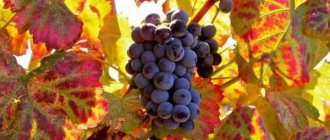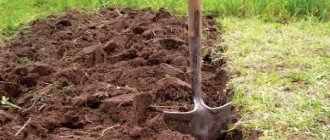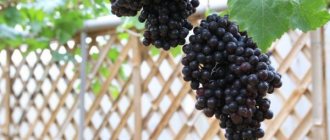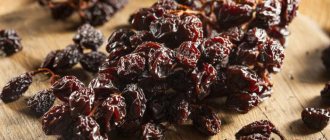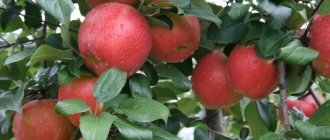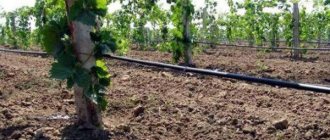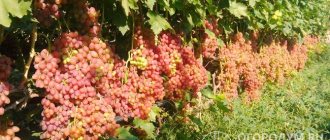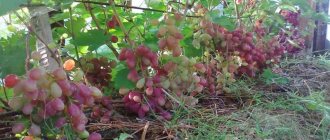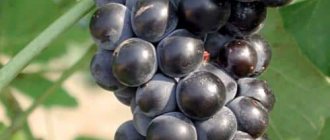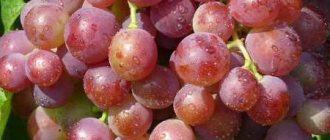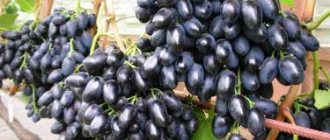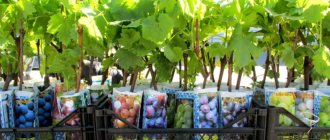What species is it?
The Izyuminka grape is an early-ripening red table grape variety. Its distinctive features are its highly elongated shape and the dark red color of the berries. The variety is not frost-resistant and is grown only in the southern regions or in greenhouses.
Crimson, Gala and Zabava are also early ripening table varieties.
How to make raisins
The grapes ripen in late August - early September (some varieties ripen until October). For a full-fledged quality product, dry sunny weather is required for several weeks after the start of ripening.
After picking the berries, they are dried for about 2 weeks in the fresh air under open sunlight in specially designated places. At the same time, the fruits are regularly mixed and protected from bird attacks.
Second drying method: on wooden racks in the shade. It takes three weeks.
The readiness of the raisins will be indicated by their changed color, appearance and consistency. The finished dried fruit is ventilated, laid out in plastic containers and stored in a dark place.
Grapes Izyuminka: description of the variety
The highlight is the tall variety.
The vine ripens well along almost its entire length. When pruning in autumn, you should leave no more than 40-45 eyes per bush. It is better to cut the vine by 10-11 buds. Isabella, Witch's Fingers and Black Delight are also distinguished by their tall bushes.
The flowers are female and require pollination. Pollinators must grow nearby: any varieties of early grapes with male flowers. Izyna is pollinated quite well.
The bunches are medium-sized, weighing up to 500 g, medium loose, not prone to peas. Only one bunch should be left on one shoot.
The berries are very large, about 10-15 grams, oblong, very elongated, uniform in size, rich dark burgundy color. The pulp is sweet, dense, marmalade. The skin is dense, but you can’t feel it when eating.
Features of culture
The grape variety Izyuminka is considered a table grape variety. And these are red grapes with early ripening. This variety is easily recognized by its large, finger-shaped berries of a rich wine color.
The hybrid is zoned for Moldova, Ukraine and the southern regions of Russia. But even in the climate of these areas, Izyuminka should be covered for the winter, since the variety is very heat-loving.
The Izyuminka grape became known only recently, because it was bred several years ago. The origin of the variety is Ukrainian; its “homeland” was the Magarach Institute of Viticulture, located on the territory of Ukraine. The “parents” for the new hybrid were the Chaush and Cardinal varieties, and the scientific name of the species obtained as a result of crossing was XVII-241.
It is no coincidence that the new hybrid received the more poetic name “Zest”. Winegrowers noticed an amazing feature of the variety: if you do not rush to harvest and leave a few uncut bunches on the vine, in a couple of weeks they will turn into wonderful raisins.
Description of the variety Izyuminka:
- The grapes ripen early - at least 110-115 days must pass from the moment the buds open until the fruits are fully ripe;
- the bushes are very tall, the vine has good and fast growth, ripens along almost its entire length;
- inflorescences on the bushes Raisins are only female, that is, the flowers do not have stamens and cannot self-pollinate (therefore, next to the variety in question, it is necessary to plant other grapes with the same early ripening periods and bisexual or male inflorescences);
- The grapes are pollinated well, the bunch set is normal;
- bunches of Raisin are large, loose, cone-shaped;
- the average weight of one bunch is 400-500 grams;
- when pruning and rationing, one bunch is left on each shoot;
- “peating” of berries is not typical for the variety - all fruits are approximately the same in size and shape;
- the berries are very large - about three centimeters in length and weighing 10 grams;
- the shape of the fruit is oblong, very elongated (shown in the photo);
- the color of the berries is dark, rich, red-violet;
- the pulp is dense, crispy, with a marmalade structure;
- Izyuminka has a wonderful, balanced, sweet taste;
- sugar content in grapes is 15-20%;
- the peel on the berries is dense, but is practically not felt during eating;
- the yield of Zest grapes greatly depends on the age of the vine and the care of the bush;
- it is believed that the yield of this variety is low: in the first years it is possible to remove only a few kilograms from a bush, later the figures can reach 15-18 kg from each plant;
- with proper care, the vine begins to bear fruit only in the third or fourth year after planting;
- The raisin is not pruned in the first years after planting - this is what distinguishes the variety from many others;
- The frost resistance of grapes is weak - without shelter the vine can withstand a temperature drop to a maximum of -12-15 degrees;
- The variety has practically no resistance to diseases and pests, so the main work of the winegrower will be preventive treatments of the vines.
Advantages and disadvantages
Praise for the Izyuminka variety is rare: the winegrower must be prepared for regular spraying of the vine and a constant struggle for the integrity and health of the bush. As mentioned above, many people like the appearance and taste of this grape, but growing Zest is a dubious pleasure.
The variety has several advantages:
- excellent presentation;
- large size of bunches and berries;
- excellent taste and high sugar content in fruits;
- a large percentage of vitamins and valuable microelements found in fruits;
- suitability of grapes for transportation and long-term storage (in cellars or refrigerators).
When to sow pepper seedlings: favorable days according to the lunar calendar in 2021, based on the age of the seedlings and the climate of the region
When listing the strengths of the Izyuminka grapes, one cannot fail to mention the real possibility of increasing harvest volumes through proper agricultural technology and intensive care.
Unfortunately, this beautiful and tasty grape also has disadvantages, and they are quite significant. All the disadvantages of the variety are associated primarily with its capriciousness. The following factors upset winegrowers most:
- whimsicality to the composition of the soil and its nutritional value - on poor soils, the Raisin bears fruit very poorly, and the leaves on the vine become small;
- weak immunity, due to which winegrowers have to fight various pests and infections throughout the warm season;
- low frost resistance - the vine without shelter can withstand temperature drops of only -12 degrees;
- late fruiting - only six years after planting can you expect the first normal harvest;
- low yield, strongly related to the amount of fertilizer and regular care.
In this situation, even more frequent pruning does not help, since trimmed bushes grow even faster and more abundantly. All this leads to depletion of the vines and a decrease in the yield of the entire vineyard.
Photo
Photo of grapes “Izyuminka”:
History of selection
The Izyuminka variety was developed at the Ukrainian Institute of Grapes “Magarach” relatively recently. It was obtained by crossing the Chaush and Cardinal varieties, and has a second name XVII-241.
It is no coincidence that this variety is called a highlight. Its berries have an amazing property: if you do not remove them from the bush for a long time, they do not overripe or rot, but wither and turn into raisins right on the vine.
Karmakod, Russian Korinka and Kishmish Stoletie are also good for raisins.
This variety is zoned in Moldova, Ukraine and southern Russia. It is recommended to grow only in warm climates and with obligatory shelter for the winter.
The benefits of raisins
People began to obtain raisins several thousand years ago. And already ancient healers knew about the benefits of dried fruit. And as you study the product, the “piggy bank” of its usefulness is only replenished.
- The dried fruit contains nicotinic acid and B vitamins. Raisins act as a sedative.
- A component of the product, such as potassium, has a beneficial effect on the functioning of the cardiovascular system, strengthening the heart muscle and improving the process of hematopoiesis.
- Raisins have proven themselves to be an excellent remedy for cold symptoms. It softens dry and hard cough, transforming it into phlegm. The product also relieves sore throat and nasal congestion.
- Dried grapes have diuretic properties, so they are used to treat the kidneys and bladder.
- The arginine included in the composition has a good effect on men's health.
- Dried fruit is good for the gastrointestinal tract: it has choleretic properties, normalizes intestinal microflora, and relieves constipation.
- Raisins are also used as a remedy for certain types of lichen. It is cut into 2 parts and the incision site is applied to the affected area of the skin.
Care instructions
The highlight cannot boast of high yield and winter hardiness. Can withstand temperatures down to -12-18C. This variety begins to bear fruit late, 3-4 years after planting, and only with proper care.
In the first years, there is no need to prune the Raisin.
Before sheltering for the winter, it is advisable to leave the maximum number of shoots near the bush. Over time, the plant will gain enough strength and begin to bear fruit.
The first few years the harvest will be very small, about 2-3 kg per bush. Over time, it can increase to 7-8 kg. It is important to properly care for this variety and carry out timely preventive treatment against diseases and pests.
If you are looking for a high-yielding variety, pay attention to the Gift of Magarach, the Anniversary of the Kherson Summer Resident and the Memory of Dombkovskaya.
Forum statistics
207036 Messages in 1634 Topics from 5593 Users. Last user: Amaya Last message: “Let's talk about the weather in Vash...” ( Today at 07:52:22 ) Latest messages on the forum.
Now on the forum
60 Guests, 10 Users
Users in the last 15 minutes: Yura, Evgeniy52, GALINA ANOKHINA, DorontsovPyotr, ZaycevAS, Alex65, 77volt, 64nikolay64, Vova Kapran, Vasily 53 [Blocked] [Section Moderator] [Forum Moderator]
Maximum online today: 77 . All-time maximum online: 2758 (28 July 2021, 17:22:51)
Users who visited the forum in the last 24 hours
Total: 293
(Visible: 292, hidden: 1) 1963, Evgeniy52, Yura, Galina Anokhina, Dorontsovpecter, Zaycevas, Alex65, 77volt, 64nikolay64, Vova Capran, Vasily 53, ZSB, Polina77, Snoices, Mikhail Alekseevich, Svetla777, Svetla777, Svetla, Marshy, Marshal, Nikolai, Nikolai, Nikolai, Nikolai, Nikolai, Nikolai, Nikolai, Nikolai, Nikolai, Nikolai, Nikolai, Nikolai, Nikolai, Nikolai, Nikolai, Nikolai. S., therapist, Liza, Capricorn, lomakin1969, Alexander Vl., Elvira2017, Andrey76, Slavka, Mikhail77, ElenkaF, Tatyana B, Cherkessk, Eugene, Leonidych, vladimirM, yotmast, mers, Serg1707, SNovichek, hanter64, znakomij, Alexander K , Vardan, Sergey Fer, Anatoly Sivkov, Alexey V, Ilya 77, Andrey Gladilin, Tatyana A., Belgorodets, in Astrakhan, Oksana Kopp, sem_en, Vladimir 153, skier, Igor Viktorovich, slavalimon, Primorets, OlgaOs, SANYCH, 31rus, mystic69, Andrey Tsvetkov, Buba, igor222, Elena Z, vlad51, Kenig, Nikolay Rex, Sergey 1965, Vladimir Buturlakin, DSW, psv1960, Dmitry 77, Vasily V., Vyacheslav03, Natalia Nikolaevna, Sergey Tashchiyan, Igor Sergeevich, alexsandr, kvg , Pioneer, Polyanina Ekaterina, nicson7, Elena Aleshchenko, Alexander-ask-34, Verona, Igor F., Taker, Henry, Yuri72, L.A.P., Gaivoronsky Yuri, Sergeevich, Sergey Chistokletov, Svetlana Streletskaya, Galinka, Alexey Deminov, Naumov Igor, Vyacheslav136, Gruey, Katrin, Andsanych, Alexander Mikhno, Grandfather, Filippov Oleg, Vladimir ++, Lidia58, Alexander Bryansky, Vladimir-Kanevskaya, Dil, Amber7394, Marina Protasova, Linx, Alexander66, Natalia M , Mikhail Fesenko, Amaya, Alexander71, Boris 1952, tsv, Maximilian, 25nata35, nadia, Igor_K, Alexander Kolesnikov, Ivan Levin, Pitko, weather forecaster, eSAa, cecet71, atseton, Alexander Smirnov, Vladimir Kostochkin, Vladimir Berdnikov, Gocha, pioneer 2, LeXa_KoT, Sergey 61, Sergey Yuryev, Erem, alexss, Skif, Vladimir Kovba, dayton, Yuri Semyonov, N.A. Sokolov, Pavlentiy, Sa-shura, Volgogradka, Dmitry Anatolyevich, Grandfather Igor, Andrey Lis, Bublichenko Alexander M , Marina Krymskaya, stenlly2010, irahelm, Vyacheslav Vladimirovich, Vladimir Shilov, Aprel, Dmitry Badaev, gheo55, y_fed, rambo, Yagodka, Valentina Ivanovna, Kryn, oleg9f, DED2, Svetlana Korotina, Oleg Ivanovich Zavezen, Eduard., santra, L2k2m7n , Alexander48, Viknik, Andrey 31, m2d, Valery Rastorguev, Yura Soshnin, Amateur gardener, Galina, Vasily1111, gardener, marlin64, Salex, sergei, Sergey Ko, Ramiz, Victor_, kosmos, potap05, Yuri 36, VitalySD, Inna161, Vladimir Shcherbinin, Valerie, niy1, cfibr, Andrey68, kulol3, thanatos, Serzh1978, Realist, Artur53, max2008-01, LOZA, AlexanderD, Ded Molodoy, Natasha, Zayac, ketch, Rita, alx-74, Iv Iv, Alexander150, Igor K , Vasily Viktorovich, VeraNiK, kdm57, Veniaminovich, Boris Sokolyansky, , vikbublik, neposny, Evgen, Victoria Aleksandrovna, Serezha 64, Wintel, Airbone, teri, Sergey Lomonosov, Khramov, serginio, Leonty Yarygin, Irina O., Ser, Nadezhda Grig , Lyubov S., netolya, Saisan, Alexey Agryzkov, Vadi, Zinaida, Vadim, Alexander Taganrog, Sergey Sukhonos, Snezhinets, evgen_26, nau_63, Masha_sadovod, Gennady163, krasnovlad1, Alexander Zinoviev, Roman Fedorovich, TIS, Alexey Sergeevich, arnyusha, Zheka , Nurtas, kradievska, nick041, Valentina Medvedeva, Sergey43, Andrey S., Nikolay Lipunov, Mst, Vertuoz2, Vladimir VS, NatalyaMed, freesia, Kinna, Mikhail Michurinsk, alekcsan1, VALERY TAMB, Sasha57, MikhAf, Y_Azer, Andrey Beribesov, hunter1955 , nut lover, Keys, Ivan Shmelev, Pestle, anton_slash, Nadymchanka, Sergey 31, Volgar, Pavel 64, Tatyana Volzh, Elektronik_t, Alexander 61
Diseases and pests
Another feature of the Raisin is its susceptibility to disease. She is very often affected by:
- mildew;
- bacterial cancer;
- gray mold;
- oidium;
- anthracnose;
- escoriosis.
May be attacked by pests:
- grape mite;
- spider mite;
- phylloxera.
This variety is one of the first to be affected by mildew
To avoid this, you need to carry out preventive treatment of the bush with Bordeaux mixture at least 3 times a season, use phosphorus-potassium fertilizers and carefully mulch the soil around the plant.
If infection occurs, the affected shoots and leaves are removed and sprayed with fungicides. This is the most common and dangerous disease for grapes. It can completely destroy not only the crop, but the entire vineyard.
Bacterial canker appears in places where the vine or shoots are damaged in the form of a large bubble-like growth. It occurs from an infection brought into the wound. Over time, all shoots located above this growth simply die off, which can lead to the death of the plant.
At the initial stage of the disease, the growth can be cut off and the wound treated with a special preparation. If the disease is already advanced, you will have to completely remove and burn the bush. Grapes can be planted in this place only after 3 years.
Gray rot is also often found on Izyuminka. It affects inflorescences and berries. To combat it, it is good to use spraying with a soda solution. Affected berries are immediately destroyed.
Oidium appears on this variety no less often than mildew. In this case, timely treatment of the vineyard with a powder or aqueous solution of sulfur will help. It can be carried out both for treatment and for the prevention of oidium.
Anthracnose appears as dark spots on the leaves. Over time, spots appear on shoots and berries and, growing, can destroy the entire bush. To avoid this unpleasant disease, you need to regularly fertilize the vineyard, treat the leaves with a solution of manganese or Bordeaux mixture and moisten the soil in a timely manner.
Escoriosis or black spot appears as black spots on shoots and leaves. This is also a rather dangerous disease that can destroy a vineyard. All affected parts of the bush are removed, after which they are treated with special preparations.
Pests cause no less harm to Zisin than diseases. Grape mites and spider mites are easy to detect at an early stage, by the appearance of tubercles and dark spots on the leaves. For control, treatment with acaricidal preparations is used. As a preventive measure, you can use spraying with infusions of dandelion or garlic.
Phylloxera is somewhat less common. If root phylloxera appears, treatment will not help. The entire bush is cut down and burned. You can get rid of leaf phylloxera by treating the vineyard with certain preparations.
The Izyuminka grape variety not only has an exceptional taste, but is also very beautiful in appearance. However, to fully enjoy all the advantages of this variety, you need to make a lot of effort.
Among the beautiful varieties, it is worth paying attention to Romeo, Chocolate or Taifi.
Beginners in viticulture should not start Izyuminka on their plot. It requires increased attention and careful care. But if you create for her all the conditions for growth and development, then she will fully reward you with an excellent, tasty harvest.
